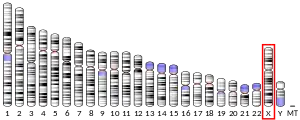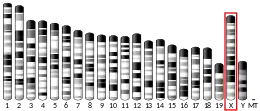| IGSF1 | |||||||||||||||||||||||||||||||||||||||||||||||||||
|---|---|---|---|---|---|---|---|---|---|---|---|---|---|---|---|---|---|---|---|---|---|---|---|---|---|---|---|---|---|---|---|---|---|---|---|---|---|---|---|---|---|---|---|---|---|---|---|---|---|---|---|
| Identifiers | |||||||||||||||||||||||||||||||||||||||||||||||||||
| Aliases | IGSF1, CHTE, IGCD1, IGDC1, INHBP, PGSF2, p120, immunoglobulin superfamily member 1 | ||||||||||||||||||||||||||||||||||||||||||||||||||
| External IDs | OMIM: 300137 MGI: 2147913 HomoloGene: 1195 GeneCards: IGSF1 | ||||||||||||||||||||||||||||||||||||||||||||||||||
| |||||||||||||||||||||||||||||||||||||||||||||||||||
| |||||||||||||||||||||||||||||||||||||||||||||||||||
| |||||||||||||||||||||||||||||||||||||||||||||||||||
| |||||||||||||||||||||||||||||||||||||||||||||||||||
| |||||||||||||||||||||||||||||||||||||||||||||||||||
| Wikidata | |||||||||||||||||||||||||||||||||||||||||||||||||||
| |||||||||||||||||||||||||||||||||||||||||||||||||||
Immunoglobulin superfamily, member 1[5] is a plasma membrane glycoprotein encoded by the IGSF1 gene,[6][7][8] which maps to the X chromosome in humans and other mammalian species.
Function
IGSF1's function in normal cells is unresolved. The protein is a member of the immunoglobulin (Ig) superfamily. It was predicted to contain 12 Ig loops, a transmembrane domain, and a short cytoplasmic tail. However, during translation of the protein, it is cleaved into amino- and carboxy-terminal domains (NTD and CTD, respectively).[9] Only the CTD is trafficked to the plasma membrane. The NTD is trapped within the endoplasmic reticulum (ER). Pathogenic mutations in the IGSF1 gene block the transport of the CTD to the plasma membrane.
Clinical relevance
Mutations in IGSF1 cause a condition called IGSF1 deficiency syndrome[10] or central hypothyroidism/testicular enlargement (CHTE[11]). The condition, which affects an estimated 1:100,000 people,[12] is more common in males than females. Most affected males are discovered through neonatal screening for hypothyroidism. The extent of hypothyroidism is variable, but most male cases require treatment with thyroid hormone replacement. Males with IGSF1 deficiency exhibit enlarged testicles (also known as macroorchidism) and a delay in the development of secondary sexual characteristics. Post-pubertally, there is no evidence of impaired fertility in these men.
The IGSF1 gene is also active in the brain and in the developing liver. It can also become reactivated in liver cancer (hepatocellular carcinoma).[13]
Animal model
Mice lacking a functional Igsf1 gene similarly exhibit hypothyroidism of central origin.[10] The IGSF1 gene is particularly active in the pituitary gland. The pituitary synthesizes and secretes thyroid-stimulating hormone (TSH). TSH, in turn, stimulates production of the thyroid hormones, thyroxine and triiodothyronine, by the thyroid gland. TSH secretion is controlled by thyrotropin-releasing hormone (TRH), which is released by neurons in the hypothalamus of the brain. In Igsf1 deficient mice, the receptor for TRH is downregulated in the pituitary.[10] This decrease could explain, at least in part, the central hypothyroidism observed in both humans and mice with IGSF1 deficiency. How the loss of IGSF1 causes a decrease in TRH receptors is presently unknown.
References
- 1 2 3 GRCh38: Ensembl release 89: ENSG00000147255 - Ensembl, May 2017
- 1 2 3 GRCm38: Ensembl release 89: ENSMUSG00000031111 - Ensembl, May 2017
- ↑ "Human PubMed Reference:". National Center for Biotechnology Information, U.S. National Library of Medicine.
- ↑ "Mouse PubMed Reference:". National Center for Biotechnology Information, U.S. National Library of Medicine.
- ↑ "Entry 300137: Immunoglobulin superfamily, member 1; IGSF1".
- ↑ Mazzarella R, Pengue G, Jones J, Jones C, Schlessinger D (Mar 1998). "Cloning and expression of an immunoglobulin superfamily gene (IGSF1) in Xq25". Genomics. 48 (2): 157–62. doi:10.1006/geno.1997.5156. PMID 9521868.
- ↑ Frattini A, Faranda S, Redolfi E, Allavena P, Vezzoni P (Jul 1998). "Identification and genomic organization of a gene coding for a new member of the cell adhesion molecule family mapping to Xq25". Gene. 214 (1–2): 1–6. doi:10.1016/S0378-1119(98)00253-4. PMID 9729118.
- ↑ "Entrez Gene: IGSF1 immunoglobulin superfamily, member 1".
- ↑ Robakis T, Bak B, Lin SH, Bernard DJ, Scheiffele P (Dec 2008). "An internal signal sequence directs intramembrane proteolysis of a cellular immunoglobulin domain protein". The Journal of Biological Chemistry. 283 (52): 36369–76. doi:10.1074/jbc.M807527200. PMC 2662301. PMID 18981173.
- 1 2 3 Sun Y, Bak B, Schoenmakers N, van Trotsenburg AS, Oostdijk W, Voshol P, Cambridge E, White JK, le Tissier P, Gharavy SN, Martinez-Barbera JP, Stokvis-Brantsma WH, Vulsma T, Kempers MJ, Persani L, Campi I, Bonomi M, Beck-Peccoz P, Zhu H, Davis TM, Hokken-Koelega AC, Del Blanco DG, Rangasami JJ, Ruivenkamp CA, Laros JF, Kriek M, Kant SG, Bosch CA, Biermasz NR, Appelman-Dijkstra NM, Corssmit EP, Hovens GC, Pereira AM, den Dunnen JT, Wade MG, Breuning MH, Hennekam RC, Chatterjee K, Dattani MT, Wit JM, Bernard DJ (Dec 2012). "Loss-of-function mutations in IGSF1 cause an X-linked syndrome of central hypothyroidism and testicular enlargement". Nature Genetics. 44 (12): 1375–81. doi:10.1038/ng.2453. PMC 3511587. PMID 23143598.
- ↑ "Entry 300888: Hypothyroidism, central, and testicular enlargement; CHTE".
- ↑ Joustra SD, van Trotsenburg AS, Sun Y, Losekoot M, Bernard DJ, Biermasz NR, Oostdijk W, Wit JM (May 2013). "IGSF1 deficiency syndrome: A newly uncovered endocrinopathy". Rare Diseases. 1 (1): e24883. doi:10.4161/rdis.24883. PMC 3915563. PMID 25002994.
- ↑ Patil MA, Chua MS, Pan KH, Lin R, Lih CJ, Cheung ST, Ho C, Li R, Fan ST, Cohen SN, Chen X, So S (May 2005). "An integrated data analysis approach to characterize genes highly expressed in hepatocellular carcinoma". Oncogene. 24 (23): 3737–47. doi:10.1038/sj.onc.1208479. PMID 15735714. S2CID 23148568.
Further reading
- Chapman SC, Woodruff TK (Apr 2001). "Modulation of activin signal transduction by inhibin B and inhibin-binding protein (INhBP)". Molecular Endocrinology. 15 (4): 668–79. doi:10.1210/mend.15.4.0616. PMID 11266516.
- Tanaka S, Tatsumi K, Okubo K, Itoh K, Kawamoto S, Matsubara K, Amino N (Feb 2002). "Expression profile of active genes in the human pituitary gland". Journal of Molecular Endocrinology. 28 (1): 33–44. doi:10.1677/jme.0.0280033. PMID 11854097.
- Bernard DJ, Burns KH, Haupt B, Matzuk MM, Woodruff TK (Jul 2003). "Normal reproductive function in InhBP/p120-deficient mice". Molecular and Cellular Biology. 23 (14): 4882–91. doi:10.1128/mcb.23.14.4882-4891.2003. PMC 162213. PMID 12832474.
- Tajima T, Nakamura A, Ishizu K (2013). "A novel mutation of IGSF1 in a Japanese patient of congenital central hypothyroidism without macroorchidism". Endocrine Journal. 60 (2): 245–9. doi:10.1507/endocrj.ej13-0009. PMID 23363888.
- Tajima T, Nakamura A, Ishizu K (2013). "A novel mutation of IGSF1 in a Japanese patient of congenital central hypothyroidism without macroorchidism". Endocrine Journal. 60 (2): E1682–91. doi:10.1210/jc.2013-1224. hdl:2115/57864. PMID 23363888.
- Joustra SD, Schoenmakers N, Persani L, Campi I, Bonomi M, Radetti G, Beck-Peccoz P, Zhu H, Davis TM, Sun Y, Corssmit EP, Appelman-Dijkstra NM, Heinen CA, Pereira AM, Varewijck AJ, Janssen JA, Endert E, Hennekam RC, Lombardi MP, Mannens MM, Bak B, Bernard DJ, Breuning MH, Chatterjee K, Dattani MT, Oostdijk W, Biermasz NR, Wit JM, van Trotsenburg AS (Dec 2013). "The IGSF1 deficiency syndrome: characteristics of male and female patients". The Journal of Clinical Endocrinology and Metabolism. 98 (12): 4942–52. doi:10.1210/jc.2013-2743. PMID 24108313.
- Tajima T, Nakamura A, Morikawa S, Ishizu K (Sep 2014). "Neonatal screening and a new cause of congenital central hypothyroidism". Annals of Pediatric Endocrinology & Metabolism. 19 (3): 117–21. doi:10.6065/apem.2014.19.3.117. PMC 4208260. PMID 25346914.
- Reynaert N, Braat E, de Zegher F (2015). "Congenital nystagmus and central hypothyroidism". International Journal of Pediatric Endocrinology. 2015 (1): 7. doi:10.1186/s13633-015-0003-5. PMC 4360929. PMID 25780367.




